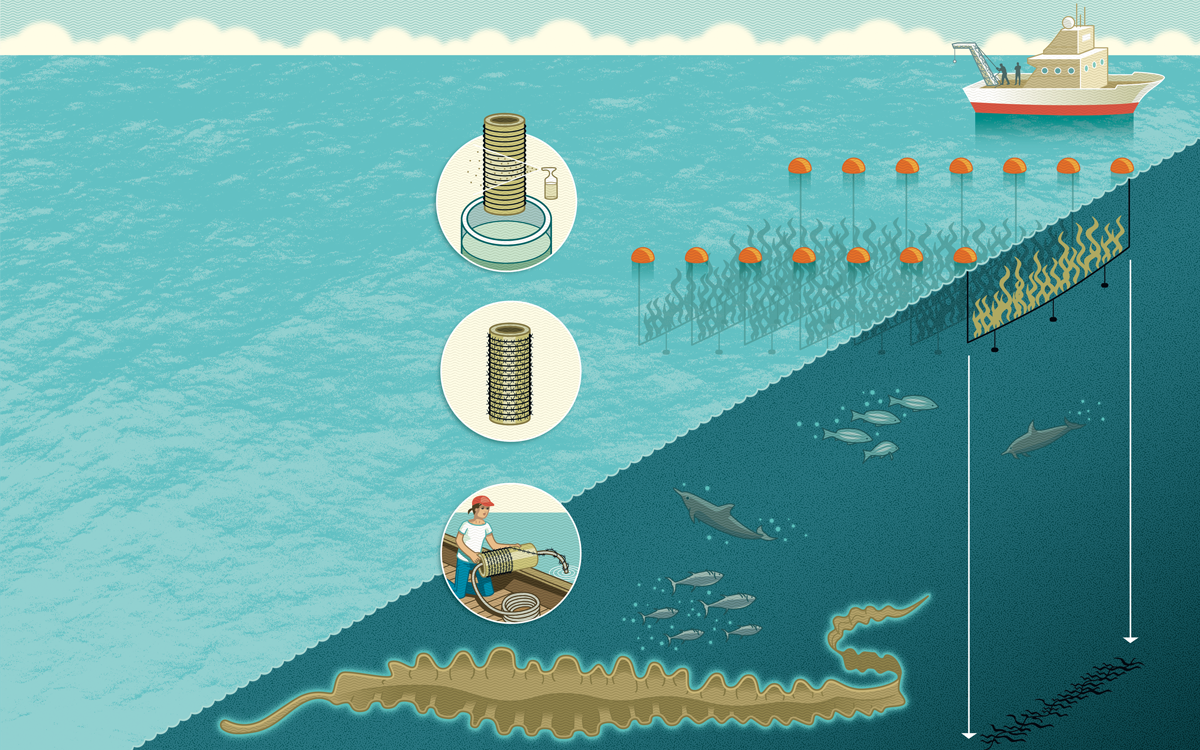Can Farming Seaweed Put the Brakes on Climate Change?
Here's how it's supposed to work

Illustration by Peter and Maria Hoey
The Claim
Seaweed has been removing carbon dioxide from the atmosphere for at least 500 million years. Recent studies suggest that wild seaweed continues to do humanity a solid by sequestering 173 million metric tons annually. The average square kilometer of seaweed can sequester more than a thousand metric tons. Start-ups like Maine-based Running Tide hope to help this process along by farming seaweed for the express purpose of sinking it and locking down its carbon. Shopify has already agreed to be the first purchaser of the resulting carbon offsets.
How It's Supposed to Work
Kelp spores are grown in a lab and then sprayed onto spools of string. These are cultivated for several weeks, until the kelp spores have grown fuzzy like Chia Pets. The string is then wound around ropes and dropped into the ocean for six to eight months, until the kelp plants reach maturity.
If the kelp were being harvested, boats would then come out and collect the ropes. But to sequester the carbon captured by the kelp, the plants need to be sunk at least 1,000 meters deep, where they will decay and not return to the surface to rejoin the carbon cycle. (The standard measure of success is removing CO2 for at least 100 years.) Researchers are studying the best ways to sink the kelp—perhaps by using biodegradable buoys. By the time the kelp is mature and heavy, the buoys will no longer be able to hold it up.
Does It Work?
There's no question that seaweed removes carbon from the atmosphere, which distinguishes it from more high-tech but unproven forms of carbon capture and sequestration. But a thousand metric tons of CO2 per year per square kilometer is not that much compared with the 50 billion metric tons of greenhouse gases emitted globally every year. Seaweed farming could conceivably scale up enough to offset the carbon produced by the aquaculture industry (300,000 metric tons per year) but couldn't even begin to make a substantial contribution to the goals laid out by the Paris climate accords.
What Could Go Wrong?
While kelp and other forms of seaweed have been gathered for thousands of years, farming large amounts of seaweed and sinking it to the bottom of the ocean is new territory. It's possible that the ropes and buoys used in large-scale carbon farming could pose a threat to shipping, fishing, or aquatic wildlife.
The Upshot
Seaweed farming has promise. In addition to sequestering carbon, it can provide habitat for fish and mitigate local effects of ocean acidification. Unlike other forms of aquaculture, it doesn't depend on inputs like fish feed or antibiotics that can throw local ecosystems out of whack.
Still, the most effective way to sequester carbon is to not release it in the first place. For example, scientists recently calculated that bottom trawling (a fishing method that involves scraping the ocean floor with giant nets) releases as much carbon into the atmosphere as the entire aviation industry does—about a billion metric tons a year. A global ban on trawling could accomplish today what sinking kelp could only hope to do in the future.
This article appeared in the Summer quarterly edition with the headline "Kelp Help."
 The Magazine of The Sierra Club
The Magazine of The Sierra Club



